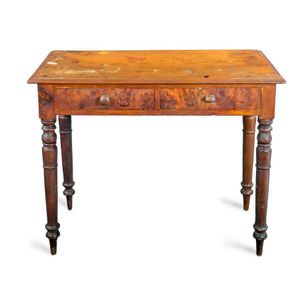18th Century Spanish Oak Hall Table with Carved Drawers
You must be a subscriber, and be logged in to view price and dealer details.
Subscribe Now to view actual auction price for this item
When you subscribe, you have the option of setting the currency in which to display prices to $Au, $US, $NZ or Stg.
- Oak - Native to Europe and England, oak has been used for joinery, furniture and building since the beginning of the medieval civilisation. It is a pale yellow in colour when freshly cut and darkens with age to a mid brown colour.
Oak as a furniture timber was superceded by walnut in the 17th century, and in the 18th century by mahogany,
Semi-fossilised bog oak is black in colour, and is found in peat bogs where the trees have fallen and been preserved from decay by the bog. It is used for jewellery and small carved trinkets.
Pollard oak is taken from an oak that has been regularly pollarded, that is the upper branches have been removed at the top of the trunk, result that new branches would appear, and over time the top would become ball-like. . When harvested and sawn, the timber displays a continuous surface of knotty circles. The timber was scarce and expensive and was used in more expensive pieces of furniture in the Regency and Victorian periods. - Baluster (furniture) - An architectural term for a column in a balustrade or staircase, often defined as a "vase shape". The shape is extensively used in furniture and decorative arts.
In furniture, it is used to describe a chair or table leg turned in that form, or more usually as an inverted baluster, with the bulbous section to the top. Less commonly used to describe a chair back that has the outline of a baluster. A baluster may also be split and applied to the front of a cupboard for ornamentation.
For ceramics and silver items it is often used to describe the shape of the whole item, rather than a part.
In Georgian glassware, the shape is commonly seen in the stem of glasses. - Rustic - Rustic is defined as "of, relating to, or typical of country life or country people", and the items illustrated in this price guide accord with that definition.
But in the 18th and 19th century "rustic furniture" had a narrower definition. It referred to furniture where the framework was carved or moulded to resemble tree trunks and branches, and was usually for outdoor use. Rustic furniture was made in cast iron, wood, terracootta and concrete. Much of the Coalbrookdale company's cast iron furniture was of rustic design.
This item has been included into following indexes:
-
tables, purpose or type
- hall 277
- rustic and primitive style 56
Visually similar items

Art Deco burr walnut console table, c. 1960, designed by Ken Ruepper, in the Oriental taste, the rectangular top above a panelled back, height 91 cm, width 184 cm, depth 36 cm. Provenance: The Estate of a Gentleman, Point Piper, NSW. Ken Ruepper was a Sydn

A provincial walnut three drawer entrance table, French, 18th century, 79 cm high, 161 cm wide, 78 cm deep

A huon pine side table, Tasmanian, circa 1850, 73 cm high, 91 cm wide, 48 cm deep

A farmhouse kitchen table, Baltic pine and blackwood, Barossa Valley, 19th century square tapering legs with peg joint construction and unusual dovetailed drawer front 76 cm high, 100 cm wide, 60 cm deep
